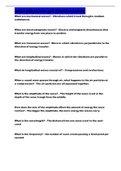Exam (elaborations)
aqa-physics-p1-flash-cards
- Course
- Institution
What are mechanical waves? - Vibrations which travel through a medium (substance). What are electromagnetic waves? - Electric and magnetic disturbances that transfer energy from one place to another. What are transverse waves? - Wave in which vibration is perpendicular to the direction of ene...
[Show more]



